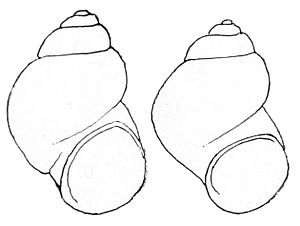Pyrgulopsis deserta facts for kids
Quick facts for kids Pyrgulopsis deserta |
|
|---|---|
 |
|
| Drawing of apertural view of two shells of Pyrgulopsis deserta. | |
| Conservation status | |
| Scientific classification | |
| Kingdom: | |
| Phylum: | |
| Class: | |
| (unranked): |
clade Caenogastropoda
clade Hypsogastropoda clade Littorinimorpha |
| Superfamily: |
Rissooidea
|
| Family: |
Hydrobiidae
|
| Subfamily: |
Nymphophilinae
|
| Genus: |
Pyrgulopsis
|
| Species: |
P. deserta
|
| Binomial name | |
| Pyrgulopsis deserta (Pilsbry, 1916)
|
|
| Synonyms | |
|
|
The Pyrgulopsis deserta is a tiny freshwater snail. It belongs to the Hydrobiidae family, also known as mud snails. People call it by a few different names. These include the desert springsnail, Virgin springsnail, and St. George snail. You can find this snail in the southwestern part of Utah and the northwestern part of Arizona in the United States.
Contents
Discovering the Desert Springsnail
This snail was first described in 1916 by a scientist named Henry Augustus Pilsbry. He originally named it Amnicola deserta. When a new species is found, scientists write a detailed description. This helps other scientists know exactly what the new species looks like.
What the Snail Looks Like
The shell of the Pyrgulopsis deserta is very small. It is about 2.4 millimeters long. That's less than a tenth of an inch! The shell is shaped like a wide oval. It is a yellowish-brown color and looks a bit see-through.
The shell has a shiny surface. It also has tiny lines that show how it grew over time. The top part of the shell, called the spire, is rounded and comes to a point. The shell has about three and a half turns, or whorls. The last turn is the biggest and curves down towards the opening.
The opening of the shell is oval-shaped. It is slightly slanted and has a pointed top. The edge of the opening is smooth and not attached to the rest of the shell.
Where the Snail Lives
These snails were first found in Washington County, Utah. This area is in the southwestern corner of Utah. The Virgin River flows through this region. The river eventually joins the Colorado River.
Scientists found these snails in "dead" shells. This means the snails were not alive when found. But the shells were not fossils. They were from snails that had recently died. Another snail, Oreohelix strigosa, was found in the same place.
Why This Snail is Special
The Pyrgulopsis deserta is a very special snail. It lives in a tough environment. The desert has very little water. Snails like this need permanent springs or streams to survive. These water sources are rare in the lower desert areas.
Because of this, the snail colonies are small. They are also few and far apart. This makes their survival difficult. Many small species live in dry regions. Scientists think this might be because of the challenging conditions. These conditions can cause them to stay small.
This article includes information from a public domain text.
- NatureServe. 2014. Pyrgulopsis deserta. NatureServe Explorer. Version 7.1. Accessed September 11, 2014.


